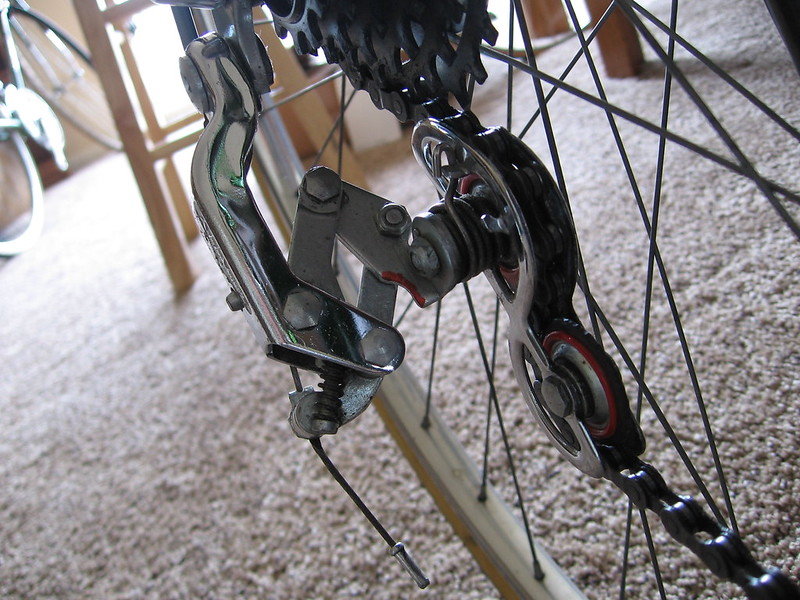Originally Posted by
dedominguez
Thank you, thank you, thank you for this amazing and comprehensive explanation! For the life of me I couldn't figure out why I couldn't fit the new 37-590 tires on my S6 wheels! Yes, I fell victim to just picking up a set of generic Kendas (37-590) to replace the crusty old tires on my 76 Racer where I couldn't even make out the tire size due to being so old and degraded.
Now, I need to replace the 27x1 1/4 tires on my Suburban and don't want to go down that same path! Further down this thread "Bad Lag" mentioned that all the 27x1 1/4 tires that Schwinn used would fit all the standard rims of the day....:
"Somewhere around 1970, Schwinn started selling an excellent, high pressure 27X1 1/4" tire. Now, high pressure back then meant only 90 psi but relative to the 60 psi I'd been limited to, that was something. It had a central tread that was "slick" (smooth) and it had file or rib pattern tread on either side. The tread was thick enough to never worry about tire life and it helped reduce punctures to very few. The tire fit all the standard rims of the day and actually allowed 90 psi inside."
So if I go and buy some "standard" 27x1 1/4 tires, will they fit the S-6 Schwinn Tubular Rim or K-2 Rim???
This is what the old tires say on the gumwalls:
27 x 1 1/4 to Fit S-6 Schwinn Tubular Rim or K-2 Rim
What's a "K-2" rim?
Thanks for this valuable info!
Daniel
The Schwinn steel 27" rims were also used on their tandems, so were made to fiercely retain the tire beads at the highest pressures that might be used.
100psi is nothing on these rims if the wire-bead tire is rated for it.
This is part of why it is often difficult to get tire beads fully seated on Schwinn rims such that the tire has no "low spots" as the wheel turns.
It can take several attempts at inflation, deflation and re-inflation before the beads pop up to the same level all the way around the rim.
It helps to use a little suds between the tire beads and the rim, and I have had issues getting Continental-brand wire-bead tires to seat on Schwinn rims under any less-than-perfect conditions (such as inflating the tire in the field using a hand pump).
It is true that the Schwinn rims could be a bit lumpy at their braking surfaces, just as the French Chrolux/Superchromix rims often featured uneven joint welds.
The French and (better-made imo) Japanese chromed rims typically weigh about 750g each (bare), while Schwinn's 27" chromed rims are more like a full 1100g each, bare! That 55% more steel equates to a huge increase in dent- and bending-resistance.
The knurling along the Schwinn rim's center weld (circumferential weld seam) was an aesthetic finishing of the unsightly weld seam, and later would become the subject of a lawsuit by Schwinn against Murray, as the knurling was presented in court by Schwinn as a trademark feature of the brand. Schwinn actually lost that case as I recall.
Chrome plating over such uneven surfaces tends to leave uneven plating thickness where surface locations become unevenly "shadowed" electrically during the plating process, so may later become sites for rusting where dirt and water may also tend to accumulate. But it's not like Schwinn's rims were any worse than other brand's chrome rims in terms of rust resistance.
The Allvit derailer works well with freewheels in the size range of 24-28t. These also work best with longer shift levers or with retrofriction levers, due to their heavy return spring.
When modified (internal clearancing for longer throw), these can even shift over a standard 6s freewheel if everything is optimally set up, but will start to show a loss of actuation linearity (longer lever throw per gear shift) as the largest (6th) cog is approached, and Schwinn levers will
just barely move far enough for this.
The Allvit ("All Vittesses" or "All Speeds") was named for it's compatibility with the late-1950's freewheels having 3, 4 and five speeds, and was perhaps the best at doing what it did using common-sized freewheels. No wonder then that Schwinn replaced their derailer bike's Simplex plunger derailers with the new Allvit!
Racers and racer-wannabees would later scoff at the Allvit's prodigious weight when lighter derailers (finally!) became available with gear-handling capabilities rivaling or exceeding the Allvit's.
And Schwinn's re-design of the Allvit cage during the early 70's added yet even
more weight. But Schwinn so valued the added chain control on their roughly-ridden entry-level bikes that they even had Shimano make 5s freewheels with a chain-catcher ring
and with driveside weather shielding.
These freewheels greatly improved Schwinn's shifting as early as 1970, and Schwinn even went to the expense of widening their rear frame spacing to 126mm to accomodate these widened 5s freewheels so as to maintain full rear wheel strength.
Clearly then, Schwinn prioritized
reliability over light weight in their rims and in their drivetrains (they also had their patented "dual plateau" chainring set to go with these features, which shifts great even today using 9s chain).
Schwinn-Approved Allvit with standard-spaced 13-30t, 6s freewheel and C9 chain:


